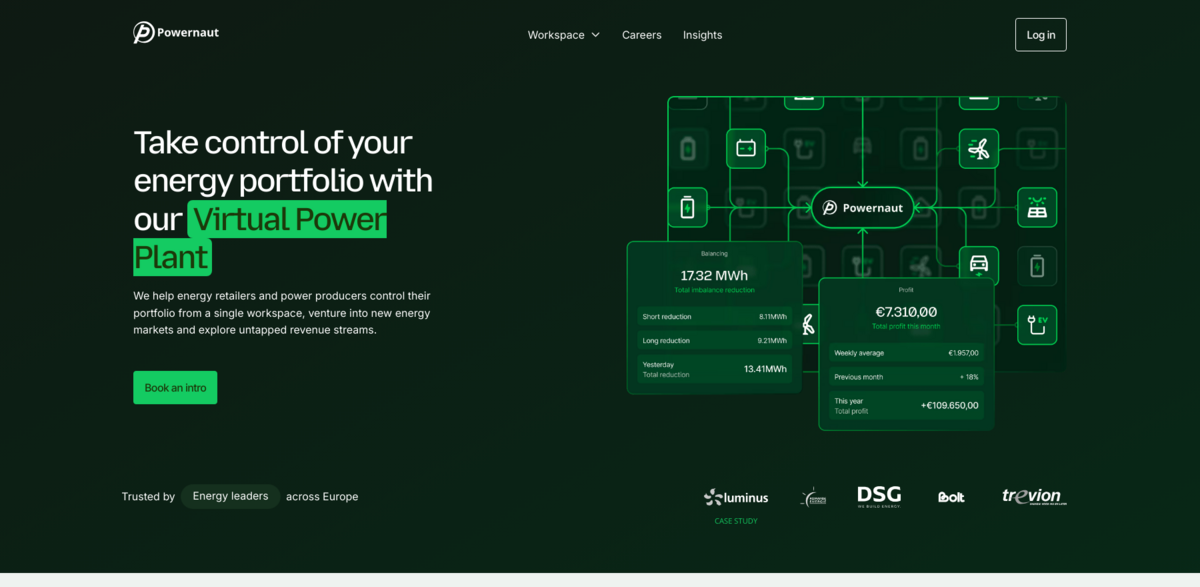What Is a Virtual Power Plant?
Imagine taking control of your entire energy portfolio from one single workspace. That’s exactly what a Virtual Power Plant (VPP) offers. It’s a smart platform designed to help energy retailers and power producers manage their distributed energy resources (DERs) seamlessly. Instead of juggling multiple systems or assets, everything connects and pools into one centralized hub. This setup not only simplifies operations but also opens doors to new energy markets and untapped revenue streams. It’s like having a bird’s-eye view of your energy assets, making it easier to balance supply and demand efficiently.
Main Benefits of Using a Virtual Power Plant
So, what’s the real advantage here? The numbers speak for themselves:
- Total imbalance reduction of 17.32 MWh — that’s a significant cut in energy waste.
- Monthly profit reaching €7,310.00 — showing that smart energy management pays off.
- Trusted by energy leaders, Independent Power Producers (IPPs), and energy retailers all across Europe.
These figures highlight how a VPP can transform energy management from a complex challenge into a profitable opportunity.
Connectivity & Aggregation: The Heart of the VPP
At the core of any Virtual Power Plant lies connectivity and aggregation. It’s all about linking your distributed energy resources into a single point of control. Whether it’s solar panels, batteries, EV chargers, or HVAC systems, the VPP brings them together. This pooling of assets creates order out of chaos, allowing operators to manage their portfolio with precision. The flexibility in connectivity means any type of asset can be integrated, making the system adaptable and future-proof.
Three-Way Connectivity: How Assets Get Connected
Connecting assets isn’t one-size-fits-all. That’s why the VPP uses a three-way connectivity approach:
- Cloud connections: Hardware-free, seamless integration that’s quick and efficient.
- Hardware gateways: Local interfaces perfect for larger installations needing reliable connections.
- Local EMS: Taps into existing behind-the-meter Energy Management Systems to optimize household energy use.
This flexible approach guarantees maximum coverage, no matter what smart assets are in play.
All Your Assets in One Workspace
Managing diverse energy assets can be tricky, but the VPP makes it straightforward. Here’s what it handles:
- Solar: Boost solar output while cutting electricity bills with peak shaving software.
- Home Batteries: Similar to solar, these batteries help reduce bills and maximize energy use.
- Commercial & Industrial Batteries: Customers get rewarded when batteries discharge during peak demand.
- EVs & Chargers: Intelligent scheduling optimizes charging rates, saving money and energy.
- HVAC Systems: Predictive energy forecasting software helps reduce peak demand costs.
Bringing all these assets into a single workspace means better control, smarter decisions, and more value.
Impact on Sustainable Development Goals (SDGs)
- SDG 7: Affordable and Clean Energy — by optimizing renewable energy and storage assets.
- SDG 9: Industry, Innovation, and Infrastructure — through advanced energy management technologies.
- SDG 11: Sustainable Cities and Communities — by reducing peak demand and improving energy efficiency.
- SDG 13: Climate Action — lowering carbon footprints via smarter energy use and flexibility markets participation.
Introducing Cloud EMS: Next-Level Energy Management
The Cloud-based Energy Management System (EMS) is a game-changer. Thanks to official OEM partnerships, it offers seamless and fully compliant integration with customer assets. This means access to real-time asset and meter data, aligning energy use with grid needs, and turning flexibility into real value. Launching smart products becomes easier, and managing customer assets remotely is more efficient than ever. It’s the future of energy management, right at your fingertips.





















